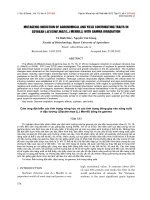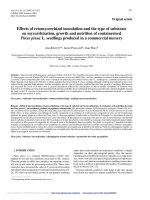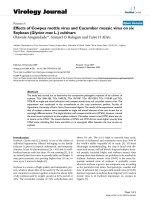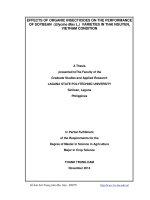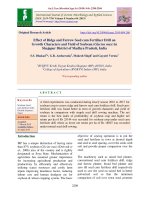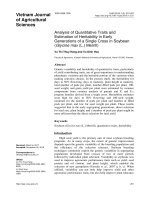Residual and cumulative effects of organic and inorganic P on economics of soybean (Glycine max L.) - Onion (Allium cepa L.) cropping sequence in a high P alfisol
Bạn đang xem bản rút gọn của tài liệu. Xem và tải ngay bản đầy đủ của tài liệu tại đây (382.09 KB, 12 trang )
Int.J.Curr.Microbiol.App.Sci (2018) 7(9): 1414-1425
International Journal of Current Microbiology and Applied Sciences
ISSN: 2319-7706 Volume 7 Number 09 (2018)
Journal homepage:
Original Research Article
/>
Residual and Cumulative Effects of Organic and Inorganic P on
Economics of Soybean (Glycine max L.) - Onion (Allium cepa L.)
Cropping Sequence in a High P Alfisol
K. Kalyani1*, V. Sailaja2 and P. Surendrababu3
1
2
Department of Soil Science, RS&RRS, Rudrur, Nizamabad, Telangana-503 185, India
Department of Soil Science, Saline Water Scheme, Bapatla, Andhra Pradesh-522 101, India
3
AICRP on Micronurients, ARI, Rajendranagar, Hyderabad, Telangana-500 030, India
*Corresponding author
ABSTRACT
Keywords
Biochar, B: C ratio,
Humic acid, Nutrient
removals, Residual cumulative effect,
Soybean equivalent yield
Article Info
Accepted:
10 August 2018
Available Online:
10 September 2018
A field experiment was conducted during kharif (soybean), 2012 and rabi (onion) 2012-13
in a sandy clay loam soils of college farm, College of Agriculture, Rajendranagar,
Hyderabad to study the response of P levels (0, 30 and 60 kg P 2O5 ha-1) either alone or in
combination with PSB @ 5 kg ha-1, biochar @ 5 t ha-1, humic acid @ 20 kg ha-1 and citric
acid @ 10 mM concentration to study the direct, residual and cumulative effects of the
treatments imposed on yield of soybean (direct) and onion (Residual and Cumulative),
soybean equivalent yield (Residual and Cumulative) and benefit : cost ratio of soybean
(direct) and onion (Residual and Cumulative). The mean seed yield of the soybean with
biochar was 2077 kg ha-1 which was significantly higher against the control seed yield of
1329 kg ha-1. Biochar resulted in a significant increase in mean onion yield to 22.1 t ha -1
against 15.8 t ha-1 when organics were not supplemented, the yield response being 39.9 per
cent across inorganic P and mode of effect. Yield of soybean - onion cropping sequence
was higher with biochar and humic acid when applied along with 30 kg P 2O5 ha-1 with
corresponding soybean equivalent yields of 7063 and 6740 kg ha-1. For soybean-onion
cropping sequence, residual effect of 30 kg P 2O5 ha-1 + humic acid was economically better
with higher B: C ratio of 2.0 followed by 30 kg P 2O5 ha-1 + biochar in both residual and
cumulative effects which showed 1.9.
Introduction
Phosphorus is a component of the complex
nucleic acid structure of plants, which
regulates protein synthesis. Phosphorus is,
therefore, important in cell division and
development of new tissue. Phosphorus is also
associated
with
complex
energy
transformations in the plant. P requirement for
soybean crop is more during pod and seed
development where more than 60% of P ends
up in the pods and seeds. Soybean is a P
dependent crop, and application of proper P
concentrations
coordinated
production,
improved physiological characteristics, and
enhanced nutrient uptake (Yan et al., 1995).
Onion is one of the most commercially
valuable vegetables grown in India. It is
considered as a rich source of carbohydrates,
1414
Int.J.Curr.Microbiol.App.Sci (2018) 7(9): 1414-1425
proteins and vitamin C besides minerals like
phosphorus and calcium. P fertilizer
recommendation for soybean and onion crops
was same.
The use of fertilizer is one of the most
important factors to increase crop yield in
soya bean production. Phosphorus is an
important element which application is
necessary for growth, development and yield
of soya beans (Kakar et al., 2002). Reasonable
yield and profit can be obtained from the
production of soybean if farmers concern
themselves with the various ways in which
growth and yield of the crop can be enhanced.
One of these ways is to consider the nutrient
requirement of the crop. This is important
because of the depletion of nutrients in the soil
caused by continuous cropping. Basso and
Rictchie (2005) suggested that for continuous
use of land for crop production, organic and
inorganic fertilizers must be incorporated into
the soil as this will provide multiple benefits
for improving the chemical and physical status
of the soil as well as improve yield of soya
bean.
Application of mineral fertilizer as soil
fertility
management
under
intensive
continuous cropping is no longer feasible due
to non-availability, high cost where available
and the numerous side effects on the soil
(Akindede and Okeleye, 2005). Farmers using
mineral fertilizer for years usually notice signs
of soil exhaustion shown by sick appearance
of the plant, leaf discolorations, retarded
growth and low yield. A combined use of both
organic and inorganic fertilizer is beneficial.
Most of the P present in soils is in unavailable
forms and added soluble forms of P are
quickly fixed by many soils. The inoculation
of phosphorus solubilizing microbes has been
shown to increase the P availability, P uptake
and crop yields. Biochar, a solid co product
from the thermo chemical production of
bioenergy, has been reported to increase
nutrient availability in soils through increased
cation retention and decreased phosphate
adsorption (Lehmann et al., 2006). In addition,
biochar is highly recalcitrant to microbial
decomposition and thus guarantees a long
term benefit for soil fertility (Steiner et al.,
2007). Low molecular weight organic acids
have been shown to decrease P adsorption and
increase P availability through complexation
of cations such as Ca, Al, and Fe (Geelhoed et
al., 1999).
Keeping in view the significance of
optimization of phosphorus fertilizers by using
organics in maintaining the soil health and
improvement in the productivity of crops and
less study on this cropping sequence, an
investigation
entitled
“Residual
and
Cumulative Effects of Organic and Inorganic
P on Economics of Soybean (Glycine max L.)
-Onion (Allium cepa L.) Cropping Sequence
in a High P Alfisol” was planned.
Materials and Methods
During kharif (soybean) 2012, the experiment
was laid out in split plot design consisting 3
main levels of inorganic P (0, 30 and 60 kg
P2O5 ha-1) and 5 sub levels of organics (no
organics, PSB, biochar, humic acid and citric
acid). In rabi (onion) 2012-13, the experiment
was laid out in split-split plot design, with 2
sub – sub levels (no application, application of
best combination from kharif to study the
residual and cumulative effects respectively).
For this all the plots were divided into two
equal halves. For one half, neither inorganic P
nor organics were applied to know the residual
effect on onion grown during rabi after
harvest of soybean crop. In another half, the
best combination from kharif was applied to
study the cumulative effects. For all the
treatments N and K were be applied uniformly
at the rate of 30 kg N ha-1 and 40 kg K2O ha-1
for soybean, 150 kg N ha-1 and 60 kg K2O ha-1
1415
Int.J.Curr.Microbiol.App.Sci (2018) 7(9): 1414-1425
for onion in the form of urea and MOP
respectively. Inorganic P will be applied in the
form of DAP and N was adjusted with urea.
The experimental soil was sandy clay loam in
texture, slightly alkaline (pH 7.64) in reaction,
non-saline (0.195 dS m-1) in nature and
medium in organic carbon (0.57 %). The soil
was low in available nitrogen (177 kg N ha-1),
high in available phosphorus (29.9 kg P ha-1)
and potassium (449 kg K ha-1) (Table 1).
Nutrient uptake (kg ha-1) by soybean and
onion were calculated using the values of per
cent nutrient concentrations and dry matter
production (kg ha-1). Soybean equivalent yield
of soybean – onion cropping sequence was
calculated.
The benefit cost ratios were computed through
partial budgeting technique by taking into
consideration the additional cost incurred due
to imposition of the treatments and the
additional returns realized, expressed in
monetary terms. The treatment without
inorganic phosphorus and organic application
was taken as control for the purpose of
comparison.
The data on various parameters was
statistically analysed following the method of
analysis of variance for split and double split
designs and the significance was tested by „F‟
test (Snedecor and Cochran, 1967). Critical
difference for comparing the treatment means
and their interactions were calculated at 5 per
cent level of probability.
(Table 2). However, the seed yield put forth
by biochar and humic acid were at a par with
the per cent yield response being 56 and 55
per cent respectively, across the inorganic P
application. The beneficial effects of biochar
are determined primarily by some of its
properties like high porosity, responsible for
its high water retention capacity; high cation
exchange capacity, which favours the
retention of nutrients and intercept their losses
and it has the ability to habitat most of the
beneficial organisms, which can increase the
release and uptake of nutrients by plants
(Atkinson et al., 2010 and Sohi et al., 2010).
Beneficial effects of humic substances were
shown on plant growth, mineral nutrition, seed
germination, seedling growth, root initiation,
root growth shoot development and the uptake
of macro and micro nutrients, in addition to
the claim that 1kg of HA can substitute for 1
ton of manure (Tahir et al., 2011).
When organics were applied alone, humic acid
recorded significantly higher seed yield of
1906 kg ha-1 over the yields obtained with the
control, PSB and citric acid treatments.
However, it was on a par with the biochar.
Integration of inorganic P at 30 kg P2O5 ha-1
with biochar showed significantly higher seed
yield of 2453 kg ha-1, which was 63.1 per cent
higher when compared to inorganic P at 30 kg
P2O5 ha-1 when applied alone. The beneficial
effects of biochar are more pronounced when
applied in combination with inorganic
nutrients rather alone (Baronti et al., 2010).
Bulb yield of onion
Results and Discussion
Seed yield of soybean
The mean seed yield of the soybean with
biochar was 2077 kg ha-1 which was
significantly higher against the control seed
yield of 1329 kg ha-1, PSB seed yield of 1287
kg ha-1 and citric acid yield of 1463 kg ha-1
Among the organics, biochar application lead
to a statistically significant positive effect on
both biomass and yield. Biochar resulted in a
significant increase in mean onion yield to
22.1 t ha-1 against 15.8 t ha-1 when organics
were not supplemented, the yield response
being 39.9 per cent across inorganic P and
mode of effect. Biochar addition can increase
1416
Int.J.Curr.Microbiol.App.Sci (2018) 7(9): 1414-1425
crop production by improving the physical,
chemical properties and soil fertility via
effects on the microbial community Lehmann
et al., 2011. Among the mode of effect
(residual/cumulative), cumulative effect was
found to show significant influence resulting
in a mean yield of 21 t ha-1 which was higher
by 22.1 per cent as against 17.2 t ha-1 due to
the residual effect. Cumulative application of
50% reduced level of inorganic P (30 kg P2O5
ha-1) along with biochar to onion, the
treatment found to fare well with soybean,
showed significantly higher yield than the
residual effect across organics and inorganic P
(Table 3).
Humic acid when applied alone resulted in the
highest soybean equivalent yield of 5629 kg
ha-1 closely followed by biochar with 5496 kg
ha-1. While, at 30 kg P2O5 ha-1, biochar put
forth higher system yield of 7063 kg ha-1
against 6740 kg ha-1 with humic acid. Similar
trend was observed at the highest level of
inorganic P application with a marginal
reduction in soybean equivalent yields of 7223
and 6661 kg ha-1 respectively. The soybean
equivalent yield due to residual and
cumulative effects was 5083 and 5848 kg ha-1
respectively.
When inorganic P was not applied to soybean,
biochar resulted in a significantly higher mean
yield of 18.9 t ha-1 against 14.2 t ha-1in the
treatment that did not receive any organics
resulting in a 33 per cent increase in the yield.
However, biochar and humic acid were
comparable in the yield and at a par.
Application of 30 kg P2O5 ha-1 alone to the
soybean across organics and mode of effects
resulted in a mean onion bulb yield of 16.4 t
ha-1 against 14.2 t ha-1 in the control, the per
cent increase being 15.5 per cent. However, 30
and 60 kg P2O5 ha-1 levels were on par with
each other. Similar response up to 30 kg P2O5
ha-1 level was observed when integration was
exercised with the organics. At this level of
inorganic P, the combination with biochar
showed significantly higher yield of 23.1 t
ha-1. Chandrika and Reddy (2011) also
reported similar yields of onion i.e., 31.18 and
23.60 t ha-1 respectively in 2004 and 2005
years (Agrifound light red).
Highest B: C ratio was observed with 30 kg
P2O5 ha-1 + humic acid (2.33) followed by 30
kg P2O5 ha-1 + biochar (2.14). It may be due to
the low cost of cultivation i.e., 57,067 Rs ha-1
for 30 kg P2O5 ha-1 + humic acid and a little
difference in yield between 30 kg P2O5 ha-1 +
humic acid and 30 kg P2O5 ha-1 + biochar.
Similar results were obtained with Madhavi
(2014) in sandy loam soils with high in P
status using maize as a test crop and reported
that the highest B: C ratio (3.84) was obtained
in treatment receiving 75 percent NPK with
biochar @ 7.5 t ha-1 followed by 75 percent
NPK with biochar @ 7.5 t ha-1 and humic acid
@ 30 kg ha-1 (3.77), while recommended NPK
alone realized a B: C ratio of 3.66. Treatment
receiving 75 percent NPK alone shows lowest
(3.30) B: C ratio (Table 5).
Soybean equivalent yield of soybean – onion
cropping sequence
When inorganic P was applied alone showed a
sharp increase to 4783 kg ha-1 at 30 kg P2O5
ha-1 and later showed a marginal increase to
4920 kg ha-1 at 60 kg P2O5 ha-1 (Table 4).
Soybean B-C ratio
Onion B-C ratio
Rabi Among all the treatments, superior B: C
ratio recorded with 60 kg P2O5 ha-1 + biochar
in residual effect (2.0) followed by 30 kg P2O5
ha-1 + biochar in cumulative effect (1.9). It
may be due to the low cost of cultivation for
residual effect i.e., 1,12,933 Rs ha-1 than
cumulative effect the value being 1,24,667 Rs
ha-1 (Table 6).
1417
Int.J.Curr.Microbiol.App.Sci (2018) 7(9): 1414-1425
Table.1 Salient soil characteristics of experimental site
S.
No.
I.
a)
Name of the property
Value
Physical properties
Textural fraction
1) Sand (%)
72.04
2) Silt (%)
7.4
3) Clay (%)
20.56
b)
Textural class
II.
Physico-chemical analysis
a)
Soil reaction (pH)
Sandy clay loam
7.64
-1
b)
Electrical conductivity (dSm )
III.
Chemical properties
a)
Organic carbon (%)
0.195
0.57
-1
b)
Available Nitrogen (kg ha )
177
c)
Available phosphorus (kg P ha-1)
29.9
d)
Available potassium (kg K ha-1)
449
Table.2 Effect of organics, inorganic P and their interaction on seed yields (kg ha-1) of soybean
Main
Sub
No organics
PSB
Biochar
Humic acid
Citric acid
Mean
Main
Sub
Main at Sub
Sub at Main
Seed yield
Inorganic P levels (P2O5 kg ha-1)
0
30
60
Mean
938
1507
1541
1329
1311
1253
1295
1287
1717
2453
2062
2077
1906
2283
1996
2062
1074
1796
1517
1463
1389
1899
1683
S.Em.±
CD (P=0.05)
25
98
53
155
92
269
65
195
1418
Int.J.Curr.Microbiol.App.Sci (2018) 7(9): 1414-1425
Table.3 Residual and cumulative effects of organics, inorganic P and their interaction on onion yield (t ha-1)
Inorganic P levels (kg P2O5 ha-1) -Main treatments
Means
Organics0
30
60
Sub
treatments Residual Cumulative Mean Residual Cumulative Mean Residual Cumulative Mean Residual Cumulative
Mean
for
Organics
No
organics
PSB
11.9
16.5
14.2
14.5
18.3
16.4
16.3
17.5
16.9
14.2
17.5
15.8
13.0
18.7
15.8
17.5
22.9
20.3
18.4
22.5
20.4
16.3
21.4
18.8
Biochar
16.3
21.5
18.9
21.2
24.9
23.1
22.6
25.8
24.2
20.0
24.1
22.1
Humic
acid
Citric acid
16.1
21.1
18.6
21.3
23.3
22.3
21.0
23.3
22.2
19.5
22.6
21.0
13.6
17.8
15.7
16.5
20.6
18.5
18.0
20.6
19.3
16.0
19.6
17.8
Mean
14.2
19.1
16.6
18.2
22.0
20.1
19.3
21.9
20.6
17.2
21.0
19.1
MT
ST
SST
MT at
ST
MT at
SST
ST at MT
ST at
SST
SST at
MT
SST at ST
SST at
MT, ST
ST,SST at
MT
MT at ST,
SST
SEm±
0.3
0.2
0.1
0.4
0.3
0.4
0.3
0.2
0.3
0.5
0.3
0.1
CD
(P=0.05)
1.1
0.6
0.4
1.2
1.2
1.1
0.8
0.6
0.8
NS
NS
NS
1419
Int.J.Curr.Microbiol.App.Sci (2018) 7(9): 1414-1425
Table.4 Soybean equivalent yield of soybean – onion cropping sequence
S. No
Treatments
soybean equivalent
yield (kg ha-1)
1
No inorganic P + No organics (Res)
3311
2
No inorganic P + No organics (Cum)
4239
3
No inorganic P + PSB (Res)
3906
4
No inorganic P + PSB (Cum)
5046
5
No inorganic P + Biochar (Res)
4970
6
No inorganic P + Biochar (Cum)
6021
7
No inorganic P +Humic acid (Res)
5126
8
No inorganic P +Humic acid (Cum)
6131
9
No inorganic P + Citric acid (Res)
3791
10
No inorganic P + Citric acid (Cum)
4629
-1
4397
-1
5168
-1
4764
14
-1
30 kg P2O5 ha +PSB (Cum)
5842
15
-1
30 kg P2O5 ha +Biochar (Res)
6685
16
30 kg P2O5 ha-1 +Biochar (Cum)
7440
11
12
13
17
30 kg P2O5 ha +No organics (Res)
30 kg P2O5 ha +No organics (Cum)
30 kg P2O5 ha +PSB (Res)
-1
6540
-1
30 kg P2O5 ha +Humic acid (Res)
18
30 kg P2O5 ha +Humic acid (Cum)
6939
19
30 kg P2O5 ha-1 +Citric acid (Res)
5100
-1
5910
-1
4793
-1
5047
-1
4975
24
-1
60 kg P2O5 ha +PSB (Cum)
5786
25
-1
6580
-1
20
21
22
23
30 kg P2O5 ha +Citric acid (Cum)
60 kg P2O5 ha +No organics (Res)
60 kg P2O5 ha +No organics (Cum)
60 kg P2O5 ha +PSB (Res)
60 kg P2O5 ha +Biochar (Res)
26
60 kg P2O5 ha +Biochar (Cum)
7223
27
60 kg P2O5 ha-1 +Humic acid (Res)
6199
28
-1
6661
-1
60 kg P2O5 ha +Humic acid (Cum)
29
60 kg P2O5 ha +Citric acid (Res)
5114
30
60 kg P2O5 ha-1 +Citric acid (Cum)
5639
1420
Int.J.Curr.Microbiol.App.Sci (2018) 7(9): 1414-1425
Table.5 Benefit-Cost ratio for Soybean crop
S.
No
Treatments
Yield
(t ha-1)
Cost of
cultivation
(Rs ha-1)
Gross
returns
(Rs ha-1)
Net
returns
(Rs ha-1)
B:C
ratio
1
No inorganic P + No organics
0.9
13235
23458
10223
0.77
2
No inorganic P + PSB
1.3
13435
32777
19342
1.44
3
No inorganic P + Biochar
1.7
18235
42932
24697
1.35
4
No inorganic P +Humic acid
1.9
15835
47652
31817
2.01
5
No inorganic P + Citric acid
1.1
13811
26852
13041
0.94
6
30 kg P2O5 ha-1 +No organics
1.5
14542
37679
23137
1.59
7
30 kg P2O5 ha-1 +PSB
1.3
14742
31333
16591
1.13
8
30 kg P2O5 ha-1 +Biochar
2.5
19542
61332
41790
2.14
9
30 kg P2O5 ha-1 +Humic acid
2.3
17142
57067
39925
2.33
10
30 kg P2O5 ha-1 +Citric acid
1.8
15118
44908
29790
1.97
11
60 kg P2O5 ha-1 +No organics
1.5
15849
38533
22684
1.43
12
60 kg P2O5 ha-1 +PSB
1.3
16049
32382
16333
1.02
13
60 kg P2O5 ha-1 +Biochar
2.1
20849
51560
30711
1.47
14
60 kg P2O5 ha-1 +Humic acid
2.0
18449
49906
31457
1.71
15
60 kg P2O5 ha-1 +Citric acid
1.5
16425
37932
21507
1.31
1421
Int.J.Curr.Microbiol.App.Sci (2018) 7(9): 1414-1425
Table.6 Benefit-Cost ratio for Onion crop
S.
No
Treatments
Yield
(t ha-1)
1
No inorganic P + No organics (Res)
11.9
Cost of
cultivation
(Rs ha-1)
37967
Gross
returns
(Rs ha-1)
59317
Net
returns
(Rs ha-1)
21350
B:C
ratio
2
3
4
5
6
7
8
9
10
11
No inorganic P + No organics (Cum)
No inorganic P + PSB (Res)
No inorganic P + PSB (Cum)
No inorganic P + Biochar (Res)
No inorganic P + Biochar (Cum)
No inorganic P +Humic acid (Res)
No inorganic P +Humic acid (Cum)
No inorganic P + Citric acid (Res)
No inorganic P + Citric acid (Cum)
30 kg P2O5 ha-1 +No organics (Res)
16.5
13.0
18.7
16.3
21.5
16.1
21.1
13.6
17.8
14.5
40992
37967
41192
37967
45992
37967
43592
37967
41568
37967
82533
64867
93383
81317
107600
80500
105633
67933
88883
72250
41541
26900
52191
43350
61608
42533
62041
29966
47315
34283
1.0
0.7
1.3
1.1
1.3
1.1
1.4
0.8
1.1
0.9
12
30 kg P2O5 ha-1 +No organics (Cum)
0.6
18.3
42304
91517
49213
1.2
13
-1
30 kg P2O5 ha +PSB (Res)
17.6
37967
87767
49800
1.3
14
30 kg P2O5 ha-1 +PSB (Cum)
22.9
42504
114733
72229
1.7
15
30 kg P2O5 ha-1 +Biochar (Res)
21.2
37967
105800
67833
1.8
16
30 kg P2O5 ha-1 +Biochar (Cum)
24.9
43704
124667
80963
1.9
17
30 kg P2O5 ha-1 +Humic acid (Res)
21.3
37967
106433
68466
1.8
18
30 kg P2O5 ha-1 +Humic acid (Cum)
23.3
44904
116400
71496
1.6
-1
16.5
37967
82600
44633
1.2
-1
20.6
42880
102850
59970
1.4
-1
16.3
37967
81300
43333
1.1
-1
17.5
43611
87650
44039
1.0
23
-1
60 kg P2O5 ha +PSB (Res)
18.4
37967
92000
54033
1.4
24
60 kg P2O5 ha-1 +PSB (Cum)
22.5
43811
112267
68456
1.6
25
60 kg P2O5 ha-1 +Biochar (Res)
22.6
37967
112933
74966
2.0
26
60 kg P2O5 ha-1 +Biochar (Cum)
25.8
48611
129017
80406
1.7
27
60 kg P2O5 ha-1 +Humic acid (Res)
21.0
37967
105067
67100
1.8
28
60 kg P2O5 ha-1 +Humic acid (Cum)
19
20
21
22
29
30
30 kg P2O5 ha +Citric acid (Res)
30 kg P2O5 ha +Citric acid (Cum)
60 kg P2O5 ha +No organics (Res)
60 kg P2O5 ha +No organics (Cum)
23.3
46211
116633
70422
1.5
-1
18.0
37967
89917
51950
1.4
-1
20.6
44187
103050
58863
1.3
60 kg P2O5 ha +Citric acid (Res)
60 kg P2O5 ha +Citric acid (Cum)
1422
Int.J.Curr.Microbiol.App.Sci (2018) 7(9): 1414-1425
Table.7 Benefit cost ratio for Soybean-Onion cropping sequence
S. No
Treatments
Cost of
cultivation
(Rs ha-1)
Gross
returns
(Rs ha-1)
Net
returns
(Rs ha-1)
B:C
ratio
1
2
3
4
5
6
7
8
9
10
11
No inorganic P + No organics (Res)
No inorganic P + No organics (Cum)
No inorganic P + PSB (Res)
No inorganic P + PSB (Cum)
No inorganic P + Biochar (Res)
No inorganic P + Biochar (Cum)
No inorganic P +Humic acid (Res)
No inorganic P +Humic acid (Cum)
No inorganic P + Citric acid (Res)
No inorganic P + Citric acid (Cum)
30 kg P2O5 ha-1 +No organics (Res)
51202
54227
51402
54627
56202
64227
53802
59427
51778
55379
52509
82775
105992
97644
126160
124249
150532
128152
153285
94785
115735
109929
31573
51765
46242
71533
68047
86305
74350
93858
43007
60356
57420
0.6
1.0
0.9
1.3
1.2
1.3
1.4
1.6
0.8
1.1
1.1
12
30 kg P2O5 ha-1 +No organics (Cum)
13
56846
129195
72349
1.3
-1
52709
119099
66390
1.3
-1
30 kg P2O5 ha +PSB (Res)
14
30 kg P2O5 ha +PSB (Cum)
57246
146066
88820
1.6
15
30 kg P2O5 ha-1 +Biochar (Res)
57509
167132
109623
1.9
16
30 kg P2O5 ha-1 +Biochar (Cum)
63246
185998
122752
1.9
17
30 kg P2O5 ha-1 +Humic acid (Res)
55109
163500
108391
2.0
18
30 kg P2O5 ha-1 +Humic acid (Cum)
62046
173467
111421
1.8
19
30 kg P2O5 ha-1 +Citric acid (Res)
53085
127508
74423
1.4
20
30 kg P2O5 ha-1 +Citric acid (Cum)
57998
147758
89760
1.5
21
60 kg P2O5 ha-1 +No organics (Res)
53816
119833
66017
1.2
-1
59460
126183
66723
1.1
-1
54016
124382
70366
1.3
24
-1
60 kg P2O5 ha +PSB (Cum)
59860
144648
84788
1.4
25
-1
58816
164494
105678
1.8
-1
69460
180577
111117
1.6
-1
22
23
26
60 kg P2O5 ha +No organics (Cum)
60 kg P2O5 ha +PSB (Res)
60 kg P2O5 ha +Biochar (Res)
60 kg P2O5 ha +Biochar (Cum)
27
60 kg P2O5 ha +Humic acid (Res)
56416
154973
98557
1.7
28
60 kg P2O5 ha-1 +Humic acid (Cum)
64660
166539
101879
1.6
29
60 kg P2O5 ha-1 +Citric acid (Res)
54392
127849
73457
1.4
30
60 kg P2O5 ha-1 +Citric acid (Cum)
60612
140982
80370
1.3
1423
Int.J.Curr.Microbiol.App.Sci (2018) 7(9): 1414-1425
B-C ratio
sequence
of
soybean-onion
cropping
Higher B: C ratio observed with 30 kg P2O5 ha-1
+ humic acid in residual effect (2.0) followed
by 30 kg P2O5 ha-1 + biochar in residual and
cumulative effects i.e., 1.9.
It may be due to low cost of cultivation (55,109
Rs ha-1) and low net returns (1,08,391 Rs ha-1)
due to 30 kg P2O5 ha-1 + humic acid in residual
effect (Table 7). Biochar and humic acid once
applied to the field it prolongs its benefit for the
next season.
Highest B - C ratio of soybean was obtained
with 30 kg P2O5 ha-1 + humic acid (2.33), while,
60 kg P2O5 ha-1 + biochar was superior with a
B:C ratio of 2.0 in putting forth the residual
effect followed by 30 kg P2O5 ha-1 + biochar in
cumulative effect (1.9).
For soybean-onion cropping sequence, higher
B: C ratio was obtained with 30 kg P2O5 ha-1 +
humic acid in residual effect (2.0) followed by
30 kg P2O5 ha-1 + biochar in residual and
cumulative effects i.e., 1.9.
applied alone showed a sharp increase to 4783
kg ha-1 at 30 kg P2O5 ha-1 and later showed a
marginal increase to 4920 kg ha-1 at 60 kg P2O5
ha-1. Humic acid when applied alone resulted in
the highest soybean equivalent yield of 5629 kg
ha-1 closely followed by biochar with 5496 kg
ha-1. While, at 30 kg P2O5 ha-1, biochar put forth
higher system yield of 7063 kg ha-1 against
6740 kg ha-1 with humic acid. Similar trend was
observed at the highest level of inorganic P
application with a marginal reduction in
soybean equivalent yields of 7223 and 6661 kg
ha-1 respectively. The soybean equivalent yield
due to residual and cumulative effects were
5083 and 5848 kg ha-1 respectively.
For soybean-onion cropping sequence, residual
effect 30 kg P2O5 ha-1 + humic acid were
economically better with higher B: C ratio of
2.0 followed by 30 kg P2O5 ha-1 + biochar in
both residual and cumulative effects which
showed 1.9. By this, one can emphasize that
biochar and humic acid applied for the
preceding crop of the sequence will benefit the
succeeding crop by the way of sustained
residual effect.
Acknowledgement
Even though, the net returns are lower (1,08,391
Rs ha-1) in case of the treatment receiving 30 kg
P2O5 ha-1 + humic acid in residual effect, the
cost of cultivation also was less (Rs. 55,109
ha-1) resulting in wider B-C ratio.
In soybean, Inorganic P at 30 and 60 kg P2O5
ha-1 across the organics significantly increased
the mean seed yield of soybean to 1899 and
1683 kg ha-1 over 1389 kg ha-1 in the control
which accounted for 36.7 and 21.2 per cent
higher yield respectively in a high P soils. The
mean seed yield of the soybean with biochar
was 2077 kg ha-1 which was significantly higher
than the control seed yield of 1329 kg ha-1. In
onion, Cumulative effect was found to show
significant influence resulting in a mean yield
of 21t ha-1 which was higher by 22.1 per cent
than 17.2 t ha-1 due to the residual effect.
Soybean equivalent yield of soybean - onion
cropping sequence when inorganic P was
Thanks to all the Professors and staff of the
Dept. of Soil Science and Agricultural
Chemistry,
College
of
Agriculture,
Rajendranagar, Hyderabad who helped for
completion of my Ph.D. thesis work.
References
Akindede, E.A. and Okeleye (2005) Short and
Long Term Effects of Sparingly Soluble
Phosphates on Crop Production in Two
Contrasting Alfisols. In: Danso, S.K.A.
and Abekoa, M.K., Eds., West African
Journal of Applied Ecology, 8,141-149.
Atkinson, C.J., Fitzgerald, J.D and Hipps, N.A.
2010. Potential mechanism for achieving
agricultural benefits from biochar
application to temperate soils: A review.
Plant and soil. 337: 1-18.
1424
Int.J.Curr.Microbiol.App.Sci (2018) 7(9): 1414-1425
Baronti, S., Alberti, G., Vedove, G.D., Gennaro,
F.D., Fellet, G., Genesio, L., Mglietta, F.,
Peressotti, A and Vaccari, F.P. 2010. The
biochar option to improve plant yields:
first results from some field and pot
experiments in Italy. Italian Journal of
Agronomy. 5: 3-11.
Basso, B. and Rictchie, J.T. (2005) Impact of
Compost Manure and Inorganic Fertilizer
on Nitrate Leaching and Yield for a 6Year
Maize-Alfalfa
Rotation
in
Midnignan. Agriculture, Ecosystems and
Environment, 108, 309-341. http://dx.
doi.org/10.1016/j.agee.2005.01.011
Chandrika, V and Reddy, D.S. 2011. Response
of onion genotypes (Allium cepa L.) to
varied planting patterns in Southern agroclimatic zone of Andhra Pradesh. Journal
of Research ANGRAU. 39(3): 21-25.
Geelhoed, J.S., Van Riemsdijk, W. H. and
Findenegg, G. R. (1999) Simulation of
the effect of citrate exudation from roots
on the plant availability of phosphate
adsorbed on goethite. European Journal
of Soil Science. 50: 379-390.
Kakar, K.M., Taria, M., Taj, F.H. and Nawab,
K. (2002) Phosphorus Use Efficiency as
Affected by Phosphorus Application and
Inoculation.
Pakistan
Journal
of
Agronomy, 1, 49-50. />10.3923/ja.2002.49.50
Lehmann, J., Gaunt, J., Rondon, M. (2006) Biochar
sequestration
in
terrestrial
ecosystems – a review. Mitigation and
Adaptation Strategies for Global Change.
11: 403-427.
Lehmann, J., Rillig, M.C., Thies, J., Masiello,
C.A., Hockaday, W.C and Crowley, D.
2011. Biochar effects on soil biota - A
review. Soil Biology and Biochemistry.
43: 1812–1836.
Madhavi, P. (2014) Effect of biochar and humic
acid on fertilizer use and yield of maize
(Zea mays L.) in alfisols of southern
Telangana region of Andhra Pradesh.
M.Sc thesis submitted to Acharya N.G.
Ranga
Agricultural
University,
Rajendranagar, Hyderabad.
Snedecor, G. W. and Cochran, W. G. (1967)
Statistical Methods. Oxford and IBH
Publishing Company, New Delhi. 331334.
Sohi, S., Krull, E., Lopez-Capel, E and Bol, R.
2010. A review of biochar and its use and
function in soil. Advances in Agronomy.
105: 47-82.
Steiner, C., Teixeira, W. G., Lehmann, J.,
Nehls, T., de Macedo, J. L. V., Blum, W.
E. H and Zech, W. (2007) Long term
effects of manure, charcoal and mineral
fertilization on crop production and
fertility on a highly weathered Central
Amazonian upland soil. Plant and Soil.
291. 275-290.
Tahir, M.M., Khurshid, M., Khan, M.Z.,
Abbasi, M.K and Kazmi, M.H. 2011.
Lignite derived humic acid effect on
growth of wheat plants in different soils,
Pedosphere, 21(1): 124-131.
Yan, X.L., Beebe, S.E., Lynch, J.P. 1995.
Phosphorus efficiency in common bean
genotypes in contrasting soil types II.
Yield response. Crop Science. 35. 10941099.
How to cite this article:
Kalyani, K., V. Sailaja and Surendrababu, P. 2018. Residual and Cumulative Effects of Organic
and Inorganic P on Economics of Soybean (Glycine max L.) - Onion (Allium cepa L.) Cropping
Sequence in a High P Alfisol. Int.J.Curr.Microbiol.App.Sci. 7(09): 1414-1425.
doi: />
1425
